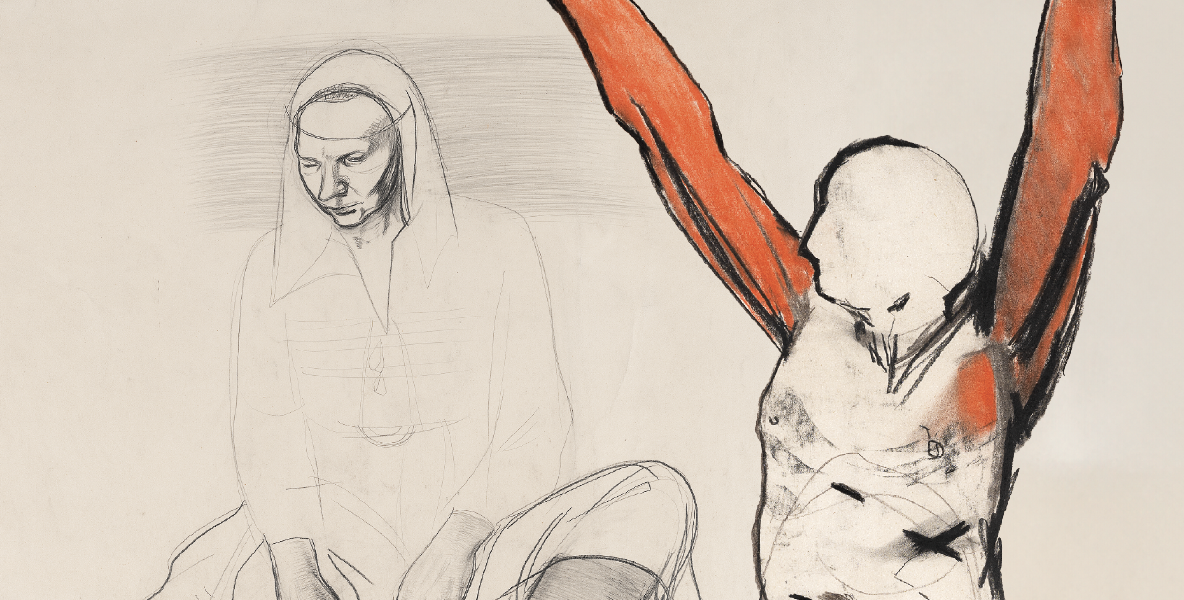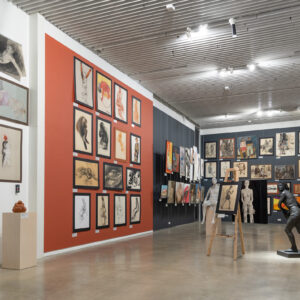
EKA Galerii
Start Date:
18.10.2024
Start Time:
17:00
End Date:
29.11.2024
EKA Museum exhibition “Clothed and Nude. 110 Years of Figure Study at the Estonian Academy of Arts”
19.10.–29.11.2024
Open Tue–Sun 12–6pm, free entry
Opening: 18.10.2024 at 5pm
In celebration of the 110th anniversary of the Estonian Academy of Arts, a significant retrospective exhibition has been organised, highlighting a theme that resonates with all who have studied here or are currently students. The depiction of the human figure – through drawing, painting and modelling from live models – has always been a cornerstone of art education, and the Estonian Academy of Arts, along with its predecessors, exemplifies this tradition.
The exhibition of the EKA Museum, titled “Clothed and Nude. 110 Years of Figure Study at the Estonian Academy of Arts”, showcases works created in the school’s studios and stored in its archives. This collection includes standing, sitting and reclining nudes, clothed models and figure groups, as well as drawings of hands and feet and other anatomical details. The selection highlights the diverse and varied ways in which the human figure can be depicted, emphasising different approaches and techniques. Academically polished images with intricate backgrounds are presented alongside monumental human representations that challenged the traditional canons at the turn of the millennium. The exhibition features both black-and-white and colour works, where classifying them as drawings or paintings based on technique or medium is no longer significant in this context.
The exhibition primarily draws from the EKA Museum’s collection, although only a small fraction of the works accumulated over the decades could be included. To represent the early decades of the school’s history, additional pieces were sourced from the Art Museum of Estonia and private collections. Figure study has also been a central theme in sculpture. However, since the original collection of the sculpture department has been lost, curatorial efforts were necessary to locate works representing three-dimensional art. Despite being in the minority, sculpture is still represented in the exhibition. Additional works were requested from artists engaged in figure study during the early 21st century to cover the period between the conclusion of the methodological collection of works at the turn of the century and the establishment of the EKA Museum in 2019. As figure drawing has been an integral part of the curriculum across all disciplines at the academy, the selection process aimed to reflect this diversity.
The exhibition features 138 artists showcasing a total of 187 works. The chance to glimpse into the formative years of well-known artists and designers is undoubtedly intriguing, while the masterpieces of lesser-known or unknown creators offer their own delightful surprises. The arrangement of the exhibit enhances this excitement by juxtaposing works not along a traditional chronological timeline, but instead focusing on the harmony and interplay between the pieces.
The artists participating in the exhibition:
Eero Alev, Jüri Arrak, Raivo Behrsin, Britta Benno, Teddy Böckler, Rem Dementjev, Olga Dubrovskaja, Herald Eelma, Jaan Elken, Herlet Elvisto, Merike Estna, Margarita Feofanova, Nikolai Guli, Heikki Halla, Gerda Hansen, Inga Heamägi, Hugo Hiibus, Aleksander Igonin, Ants Jaanimägi, Andrus Johani, Aivar Juhanson, Iris Jurma-Kangur, Sandra Jõgeva, Pille Jänes, Villu Järmut, Heli Jürissaar (Kase), Jüri Kaarma, Katrin Kaev, Catlin Kaljuste, Maria Kallau, Anu Kalm (Anderson), Elin Kard, Gleb Karlsen, Saskia Kasemaa, Alice Kask, Eve Kask, Jüri Kask, Maret Kernumees, Ando Keskküla, Kaalu Kirme, Tiiu Kirsipuu, Raoul Koik, Epp Maria Kokamägi, Ellen Kolk, Luule Kormašova, Nikolai Kormašov, Orest Kormašov, Aimar Kristerson, Mart Krull, Epp Kubu, Viive Kuks, Leili Kuldkepp, Laura Kõiv, Andrus Kõresaar, Tõnis Kärema, Annika Künnap, Allex Kütt, Vello Laanemaa, Heldur Lassi, Pille-Riin Lass, Tõnu Lauk, Emil Lausmäe, Malle Leis, Tea Lemberpuu, Ly Lestberg, Mihkel Liinat, Silvi Liiva, Bruno Lillemets, Ivika Luisk (Kivik-Luisk), Anu Maarand, Aet Maasik, Viktor Madison, Ülle Marks, Vladimir Matiiko, Aarne Mesikäpp, Rein Mets, Gregorio Migliaccio, Peeter Mudist, Maarit Murka, Tõnu Mäsak, Arseni Mölder, Reigo Nahksepp, Mall Nukke, Liisa Nurklik, Lydia Nüüd, Evald Okas, Kaido Ole, Jaan Paris, Ede Peebo, Imbi Ploompuu (Karu), Urmas Ploomipuu, Mari Prekup, Mark Antonius Puhkan, Aapo Pukk, Kaie Pungas, Brenda Purtsak, Laura Põld, Matti Pärk, Katrin Pärt, Liisi Pääsuke, Tiit Pääsuke, Tiit Rammul, Tiina Reinsalu, Uno Roosvalt, Eesi Rosenberg, Peeter Rudaš, Sirje Runge (Lapin), Tõnis Saadoja, Hugo Sepp, Kati Simpson, Piret Smagar, Jaak Soans, Tõnu Soo, Aleksander Suuman, Silja Šergalin, Juri Šestakov, Vladimir Taiger, Mari-Liis Tammi-Kelder, Endel Taniloo, Anne Tapper, Olga Terri, Evi Tihemets, Tiina Tiitus, Ilmar Torn, Margus Tõnnov, Maria-Kristiina Ulas, Peeter Ulas, Anne Vaher, Katrin Vaher, Valentin Vaher, Silver Vahtre, Mall Valk (Sooster), Janika Vesberg, Heldur Viires, Hanna Vinter, Ekke Väli, Eduard Wiiralt, Elisa Margot Winters
Curated by: Reeli Kõiv
Exhibition design and co-curation by: Britta Benno
Graphic design by: Pärtel Eelmere
Assistant:Anna Birgitta Erikson
The exhibition is accompanied by an eponymous catalogue featuring large reproductions of all the displayed works. In addition to a historical overview relevant to the theme, the book is enriched with interviews from drawing instructors Tiit Pääsuke, Matti Pärk, Maiu Rõõmus, Maria-Kristiina Ulas, Ülle Marks and Tõnis Saadoja, discussing the significance and meanings of learning to depict the human figure. These interviews are complemented by an essayistic reflection on figure drawing at the academy by printmaker and drawing instructor Britta Benno. Additionally, recollections of their student years from Peeter Ulas and Herald Eelma, gathered by Jüri Hain, are also republished.
The catalogue is authored and compiled by Reeli Kõiv, the head of the EKA Museum, and includes a foreword by Rector Mart Kalm.
The publication is a bilingual edition that combines both Estonian and English in a single volume, with language editing by Elo Rohult and translation by Epp Aareleid. The 288-page catalogue was designed by Stuudio Stuudio and printed at Tallinn Book Printers.
The exhibition is supported by the Cultural Endowment of Estonia and Sadolin Estonia.
Opening drinks from Põhjala Brewery.






























